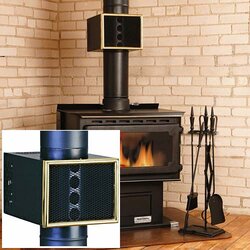- Mar 19, 2012
- 99
I modified my woodstove this winter to change the way it draws its air from naturaly drafted to sealed combustion. Instead of drawing air from inside the room (which creates drafts through the house) I force air from the crawlspace through piping directly into the firebox. I get more blue flames and use less wood to get the same amount of heat.



 .a doubled stainless steel coil 3/4" I.D. with water circulation...you see the woodstove is an indoor boiler (DIY) and it never gets too hot. The grate helps burn nice and hot to compensate for the water cooling effect. The hottest I've seen is 280 celcius at the stovetop. I never dampen the fires. In fact the damper is set up to not close down. I use short hot fires. I'm in Georgia where the heat loses generaly aren't that great. If it gets down to 20 degrees f. outside, then I'll keep adding wood, otherwise one load is usualy enough or maybe I'll toss a couple splits on top of the coals.. I let the fires go out when the living room temperature gets close to 80 degrees F. I like to keep the house in the 70's. The hot water is used for heating domestic water and for low temperature radiant floor heating. I do have lots of water storage capacity. The oak isn't seasoned two years yet....more like 1 1/2 years. I'll be burning seasoned pine also next season because I have lots of it and it burns fast and hot. The stack is 6" diameter straight up. There is a heat reclaimer with thermostatic fan about 20 inches above the stove and I try to keep the fires hot enough to keep that reclaimer fan blowing. The stove sits in a large room with an 18 foot high vaulted ceiling. The stack was pro installed and rises about two feet above the ridge of the roof. I also use another thermostaticaly controlled blower fan which blows up the back and across the top to help get heat out and away from the stove when the stove top temp is over 100 degrees celcius.
.a doubled stainless steel coil 3/4" I.D. with water circulation...you see the woodstove is an indoor boiler (DIY) and it never gets too hot. The grate helps burn nice and hot to compensate for the water cooling effect. The hottest I've seen is 280 celcius at the stovetop. I never dampen the fires. In fact the damper is set up to not close down. I use short hot fires. I'm in Georgia where the heat loses generaly aren't that great. If it gets down to 20 degrees f. outside, then I'll keep adding wood, otherwise one load is usualy enough or maybe I'll toss a couple splits on top of the coals.. I let the fires go out when the living room temperature gets close to 80 degrees F. I like to keep the house in the 70's. The hot water is used for heating domestic water and for low temperature radiant floor heating. I do have lots of water storage capacity. The oak isn't seasoned two years yet....more like 1 1/2 years. I'll be burning seasoned pine also next season because I have lots of it and it burns fast and hot. The stack is 6" diameter straight up. There is a heat reclaimer with thermostatic fan about 20 inches above the stove and I try to keep the fires hot enough to keep that reclaimer fan blowing. The stove sits in a large room with an 18 foot high vaulted ceiling. The stack was pro installed and rises about two feet above the ridge of the roof. I also use another thermostaticaly controlled blower fan which blows up the back and across the top to help get heat out and away from the stove when the stove top temp is over 100 degrees celcius.
